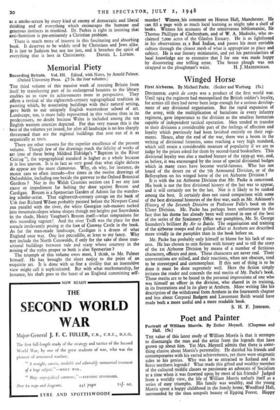Memorial Piety
Recording Britain. Vol. III. Edited; with Notes, by Arnold Palmer. (Oxford University Press. £5 5s. the four volumes.) Recording Britain. Vol. III. Edited; with Notes, by Arnold Palmer. (Oxford University Press. £5 5s. the four volumes.) THE third volume of this massive work of rescuing Britain from itself by transferring part of its endangered beauties to the library enables us to view its achievements more in perspective. They affirm a revival of the eighteenth-century topographical tradition in painting which, by associating buildings with their natural setting, gave birth to our uniquely English watercolour school of art. Landscape, too, is more fully represented in this volume than in its predecessors, no doubt because Wales is included among the ten English western counties depicted. For that very reason this is the best of the volumes yet issued, for after all landscape is no less sharply threatened than are the regional buildings that rose out of it as organically as trees.
There are other reasons for the superior excellence of the present volume. Though few of the drawings reach the felicity of works of art (one of these being Mildred Eldridge's " Baptism in the River Ceiriog "), the topographical standard is higher as a whole because it is less uneven. It is in fact so very good that what slight defects do appear are the more clamorous. Why, oh why, for instance, do motor cars so often intrude—five times in the twelve drawings of Oxfordshire, including one beside the gateway to the Oxford Botanical Gardens ? Nor in the Welsh Counties section can I see any just cause or impediment for bolting the door against Brecon and Cardigan. Brecon is a Spenserian Garden of Adonis for the wander- ing scholar-artist. That eighteenth-century cottage on the bank of Usk that Richard Wilson probably painted before the Newport Canal ran parallel with the river, the white Georgian sub-manors tucked into mountain-slopes whose shapes though not heights put Snowdonia in the shade, Henry Vaughan's Brecon itself—what temptations for this recording vagrant ! And the river Teiffi was the place for that coracle irrelevantly posing at the foot of Conway Castle in the book. As for the man-made landscape, Cardigan is a dream of what England once was. One last peccadillo, at least to my fancy. Why not include the North Cotswolds, if only for the sake of those tran- sitional buildings between vale and scarp whose courtesy in the mixing of the styles proper to both is also Spenserian ?
The triumph of this volume owes most, I think, to Mr. Palmer himself. He has brought the short notice to the point of an exquisite art. It is done with so fine a civility that an insensitive view might call it sophisticated. But with what marksmanship, for instance, his shaft goes to the heart of an England committing self-
- murder! Witness, his comment on Heaton Hall, Manchester. He can fill a page with as much local learning as might take a shelf of books. Witness his accounts of the omnivorous bibliomaniac, Sir Thomas Phillipps of Cheltenham, and of W. A. Madocks, who re- claimed 7,000 acres of the Glaslyn Estuary. He is as lightfooted in his observations as. a Red Indian, and passes his most enviable culture through he closest mesh of what is appropriate to place and subject. He is our literary miniaturist, and yet his particularities of local knowledge are so extensive that I for one was made happy by discovering one trifling error. The breast plough was not






































 Previous page
Previous page